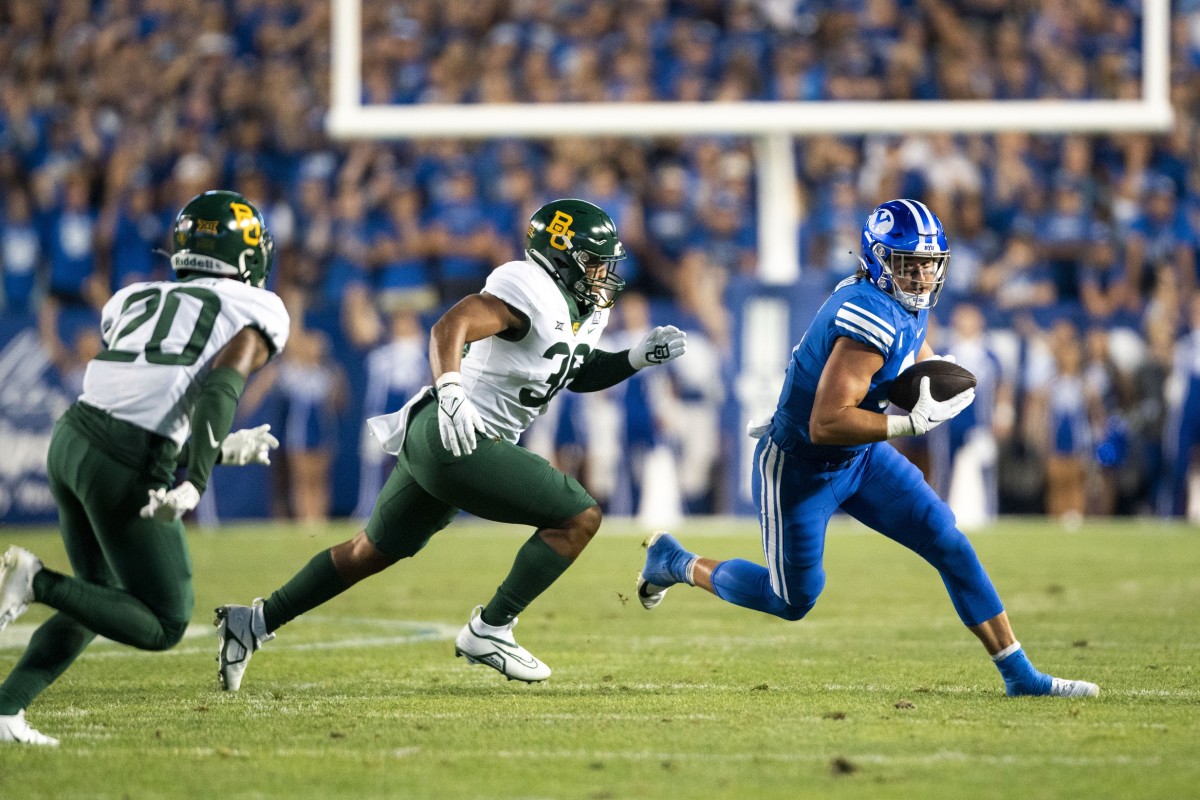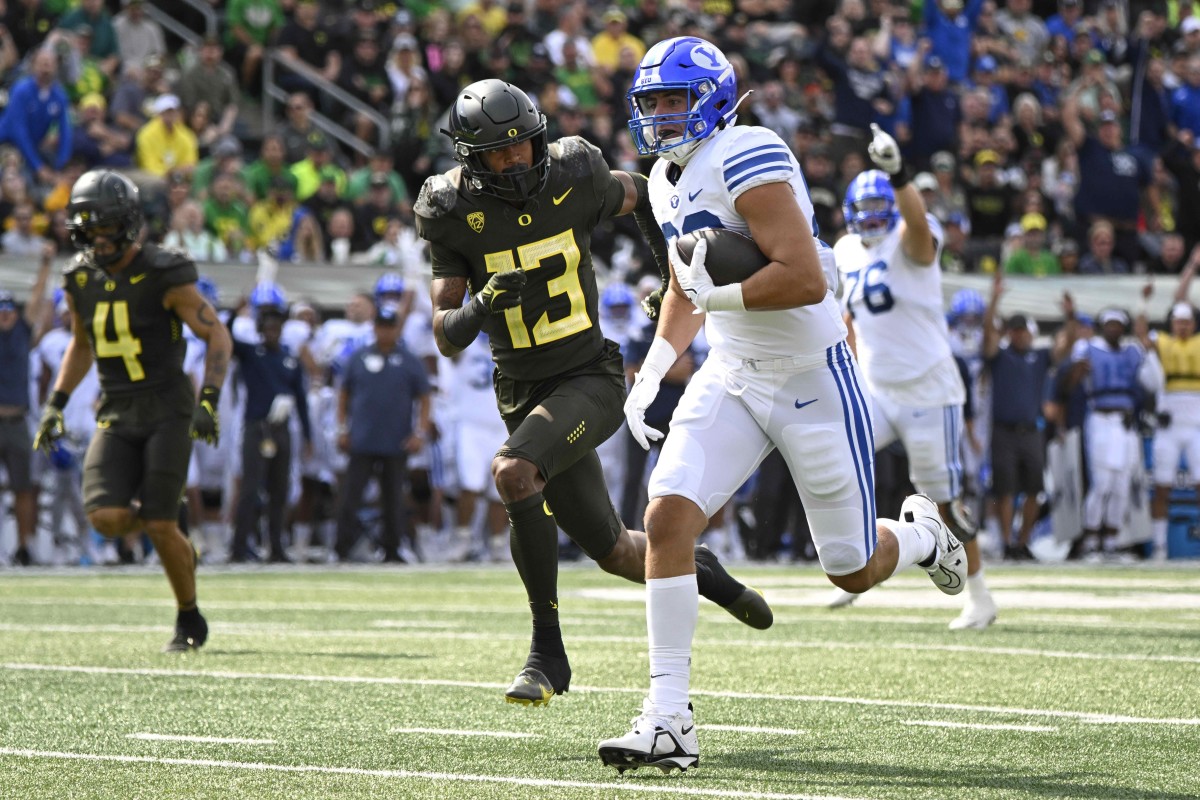Is BYU Using its Tight Ends enough?
Dallin Holker shocked everyone this week by announcing that he intends to enter to the transfer portal, citing unhappiness with his role in the BYU offense. BYU fans have quietly felt that tight ends have been under-utilized over the last two seasons, but those feelings reached a fever pitch with the news this week.
Yesterday, hall of fame BYU tight end Dennis Pitta joined BYU Sports Nation and expressed thoughts that many BYU fans no doubt share. “I just think BYU missed the mark a little bit in utilizing [its tight ends], and that’s a big reason why Dallin transferred.”
"I just think BYU missed the mark a little bit in utilizing those guys, and that's a big reason why Dallin transferred"@dennispitta gives his thoughts on BYU's use of the tight end position through 3 games. #BYUFOOTBALL | #GoCougs pic.twitter.com/Uop3ndDqFG
— BYUtv Sports Nation (@BYUSportsNation) September 23, 2022
BYU and tight ends are almost synonymous over the last 50 years, from NFL hall of famer Todd Christensen, to Gordon Hudson, to Chad Lewis, to Dennis Pitta, to Matt Bushman and on. Isaac Rex led all tight ends in the country in 2020 with 12 touchdown receptions. All of this has led some BYU fans to scream out, “Why aren’t we using tight ends more?!”
Is BYU really not using its tight ends? Or are they being used differently? Here are some truths about the tight end usage at BYU.
BYU is using tight ends more this season, not less
Let's start with this. BYU is utilizing tight ends more this season than at any point in the last four years. So far, tight ends have been targeted on 20.2% of throws, up from 18.9% in 2021 and 18.4% in 2020. So why does it feel like they are being used less?
BYU fans are used to having one big receiver threat and one big tight end threat. Think Glenn Kozlowski and Gordon Hudson, or Dennis Pitta and Austin Collie. What they are not used to is having seven legitimate threats to throw the ball to. I’d contend that the perceived tight end utilization deficiencies have less to do with total tight end usage and more to do the lack of a clear starting tight end.
While tight ends are actually being targeted more often this year, BYU’s most targeted tight end (Holker ironically) only makes up 47% of all tight end targets. Compare that to 2019 and 2020 when Matt Bushman and Isaac Rex accounted for 81.8% and 66.7% of total tight end targets respectively. What does that mean? Perhaps it's that we think BYU utilizes tight ends better when targets are really just being consolidated among fewer players.

TE usage is often a reflection of WR quality
It should be obvious that the best pass-catchers on the field tend to get the most targets. Pitta argued that NFL offenses understand that if you have a good tight end, he is usually your most targeted guy. This is false. Of the 32 NFL teams, only 2 had a tight end as their most targeted receiver in 2021. In fact, a tight end hasn’t led the NFL in receiving since Harold Carmichael did it in 1973.
Having a tight end as your number one target is more often a reflection of who you have at wide receiver. Pitta specifically mentioned Mark Andrews, who has led the Ravens in targets the last two seasons. Andrews is an incredible tight end, but he is also playing with only one receiver that was drafted higher than the fourth round.
BYU threw to tight ends on 30% of throws in 2018. Their top 3 wide receivers were Aleva Hifo, Neil Pau’u, and Dylan Collie, none of which made NFL rosters. Pitta himself led BYU in receiving in 2009 by a wide margin on a team that had zero receivers that made a 53-man roster. This is not to diminish the greatness of Matt Bushman or Dennis Pitta. Both are all time greats. I point it out only to illustrate that BYU currently has the deepest receiver room in program history, and that will naturally result in fewer targets for tight ends.
Using tight ends more doesn’t necessarily make your pass game more productive
There seems to be this belief that in order to have an offense running at full power, tight ends must be a focal point. That is simply not true. None of the top five passing offenses in America last season had a tight end as one of their top three targeted receivers. Mississippi State was fourth nationally in passing last season and they don’t have tight ends period.
BYU’s biggest year for targeting tight ends in the last five seasons (30% of targets in 2018) had the lowest number of passing yards per game (211). We need to get it out of our minds that tight ends are a magical cheat code that are always open and must be thrown to in order to succeed as an offense. They are an incredible weapon but not necessarily the most important weapon.

Lets look to the north
Utah is the gold standard of TE usage and is a perfect illustration of all three of these earlier points. Utah’s tight ends have been targeted on 48% of throws this season with Brant Kuithe making up 65% of those targets. They have two NFL tight ends in Kuithe and Kincaid, but their struggles in the WR room have been well documented by Kyle Whittingham himself. When asked how his receivers can make more of an impact in the Utah offense, he simply said “Get open.”
Utah is not necessarily known for its prolific passing attack either. The Utes have had just one 3,000 yard passer in the Kyle Whittingham era (Tyler Huntley in 2019). All this is to say, the grass is always greener on the other side of the state, but that grass has its own ugly patches.
In summary...
Look. I have also wondered why the tight ends have not been used more effectively this season, especially in the absence of Puka Nacua and Gunner Romney. I would also like to see them targeted more in red-zone situations and on third downs, but I admittedly don’t know just how much that should be. It feels like the easy answer. Plus, there is a myriad of other reasons why BYU tight end usage looks different than it did in 2020, starting with a tougher schedule and fewer mismatches on opposing defenses.
The big picture is that BYU has multiple thoroughbred tight ends in the stable, and as a result, none of them have been able to put up the gaudy numbers we have seen in decades past. However, that does not mean they are being used less often. So while we do the autopsy of Dallin Holker’s BYU career, perhaps we will see that it is not the total tight end usage, but rather Holker’s own usage relative to other tight ends that drove him out of BYU.
The good news is, BYU currently has one tight end who resembles a full grown elk and another that can literally fly. Plus, there are plenty of talented tight ends in the pipeline, including four-star 2023 commit Jackson Bowers.
Now… let's all take a collective deep breath, and enjoy as we watch Isaac Rex score 30 touchdowns this season out of pure pettiness.
